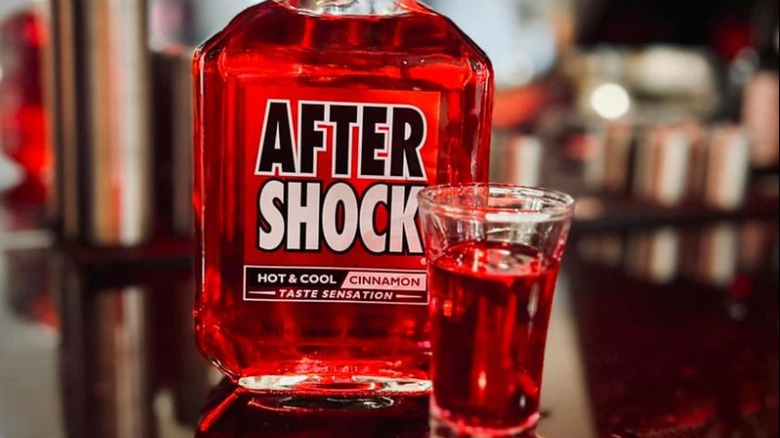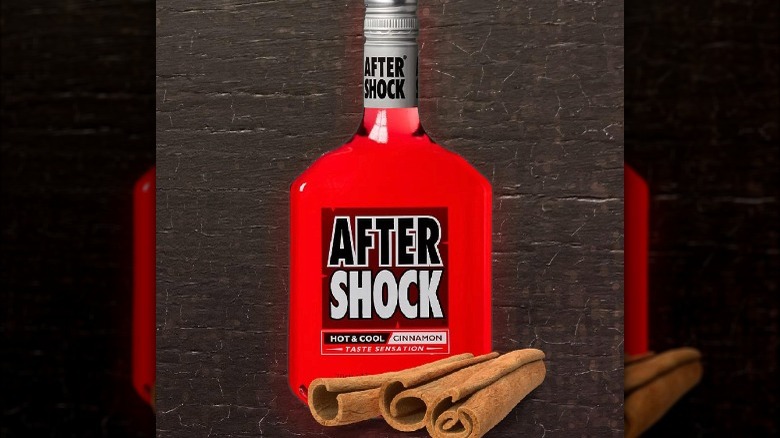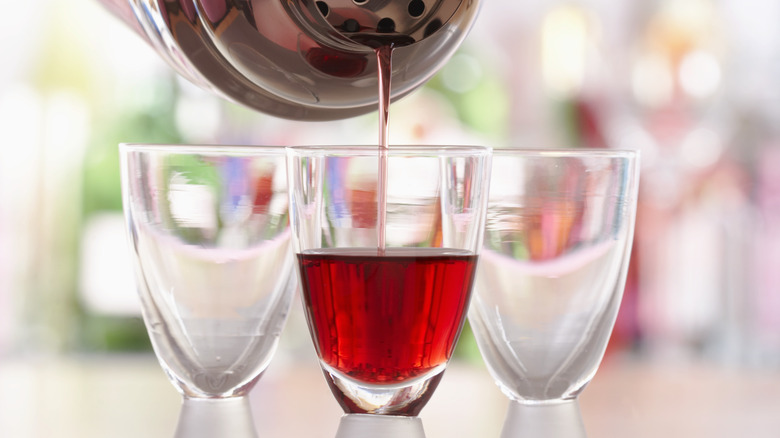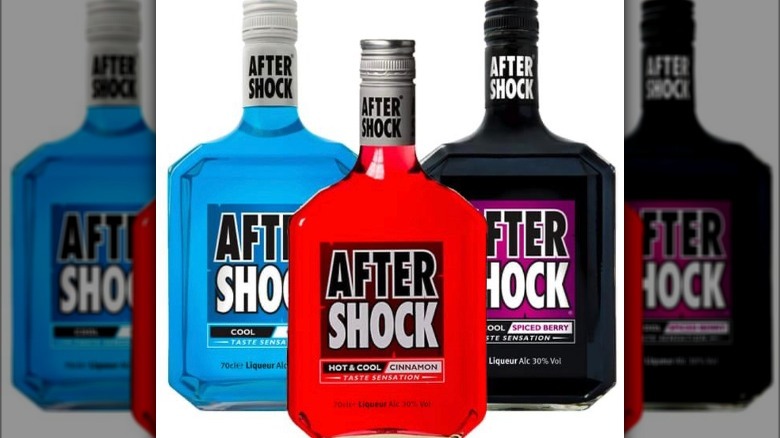What Was Aftershock Liqueur And Why Did It Disappear?
We may receive a commission on purchases made from links.
If '90s parents hated SURGE, there was a special reservoir of hatred labeled with the word "Aftershock." If you don't remember it, then it probably means you weren't around to experience the magic (or, rather, the chaos carnival) in real-time. With its electric hue, candy-like flavors, and gnarly ABV, Aftershock liqueur was the lifeblood of '90s and early-2000s frat parties. It came in five different flavors: Red cinnamon, Blue cool citrus, Black spiced berry, Orange fizzy orange, and Silver, (a combination of Red Bull and apple). But, by far, the cinnamon flavor gained the most popularity and subsequently emerged as the quintessential "Aftershock" image.
What really made Aftershock special was its hot and cold effect, the result of a cinnamon-peppermint combination that created an "icy hot" sipping sensation. Like SURGE, Aftershock was targeted at younger consumers, where it found an enthusiastic audience. Indeed, the sensorily-intriguing liqueur was fun like Fireball, a green tea shot, or a Four Loko. In other words, the average consumer isn't going to be enjoying Aftershock as an evening digestif. Aftershock is fuel for nights that live on in laughter- and cringe-inspiring stories that were a total gas, but given the choice, you wouldn't elect to relive. So, whatever happened to it?
An electrifying history
Aftershock was first launched by the Jim Beam group in April 1995. A retrospective vantage point on the history of the spirits industry would suggest that Aftershock was in the right place at the right time to enjoy a fanatical fanbase. The sugary energy drink phase of the early-to-mid 2000s had yet to hit, and the spirits industry was riding on the wave of the neon-hued, pornographically titled, ultra-sweet cocktail era of the 1980s, which birthed such zany, fabulous creatures as the Sex on the Beach, Screaming Orgasm, and Harvey Wallbanger.
Aftershock was no ordinary liqueur, either. It toted a 40% ABV — the same as standard full-proof liquors, which is kind of a big deal by liqueur standards. (For reference, vermouth has an ABV of 16%-18% and Campari packs 20.5%-28%.) The 40% ABV is like gamer juice meets jungle juice sleep paralysis demon, which might be part of the reason why in 2009, Aftershock lowered the ABV to 30%. To further deepen the mystery, there's even a rumor floating around that "Aftershock" gets its name from a trippy scientific effect: It crystallizes in your stomach, then dissolves into a liquid form again before digestion and gets you drunk not once, but twice. As rad (or low-key horrifying) as this prospect might sound, there's no merit to it.
How heyday heads surfed the Aftershock wave
Aftershock was all about the icy-spicy flavor. A listing on Amazon U.K. describes it as a "Thick, viscous texture with a pungent, spicy and sweet palate that ends with a second rush of spice." Difford's Guide describes the experience as an "Initial very sweet syrupy palate...followed by a cinnamon/peppermint burn." The spirits guide gives Aftershock a measly rating of two stars, but the liqueur didn't get famous for being "good." Thanks to its 40% ABV, Aftershock made for a super strong cocktail. Its fiery cinnamon flavor would pair well in a glass of Cherry Coca-Cola or dumped into a batch of Sangria.
You could also turn it into a cocktail with sweet tea and orange juice, or combine it with Red Bull in a shaker and rip it as a Bomb Shot. Indeed, in its heyday, Aftershock was typically enjoyed straight-up as a shooter – that is until it disappeared seemingly without explanation after an abridged 10-year run.
After Aftershock
All good things must come to an end, and in 2009, the sun set on the beautiful, party-fueled, chaotic Aftershock empire. The product was discontinued as the sun rose on a new empire: caffeine alcohol. Four Loko hit the market in 2008, packing four-to-six beers, an espresso shot, and the caffeine content of a Red Bull into a single drink. The drink quickly earned the nickname "blackout in a can" and frankly, for all its icy-hot wonder, Aftershock didn't stand a chance. This is, of course, a bit of conjecture, as there's no definitive link between the demise of Aftershock and the rise of energy-drink-booze offerings. But, the timeline does demonstrate compelling overlap for both drinks' target demographic.
Today, Aftershock is tough to track down, but it can be done. A 750 ml bottle of the classic cinnamon flavor retails for around $50 after shipping via Amazon U.K. Via Drink Supermarket, the same bottle similarly retails for about $25 with another $20-ish in sales tax. It's $119.99 on Cask Cartel. (Our advice? Stick to Fireball.)



